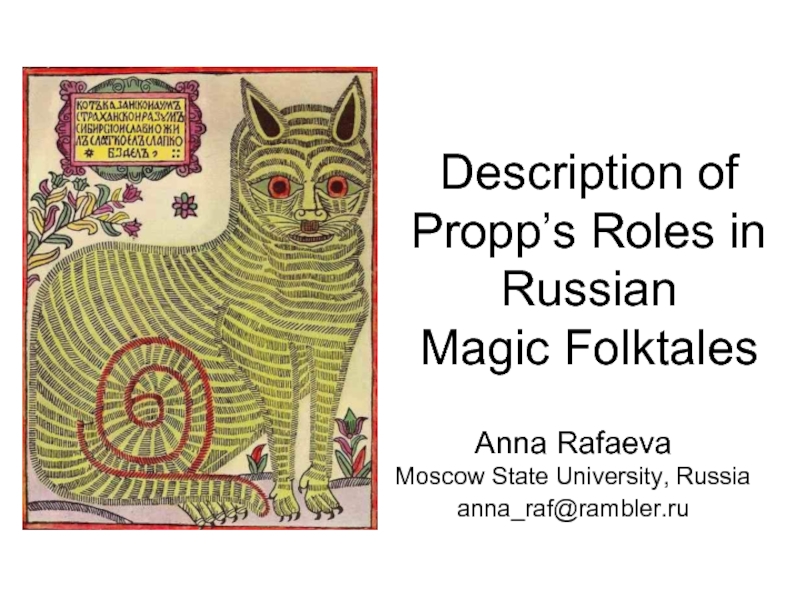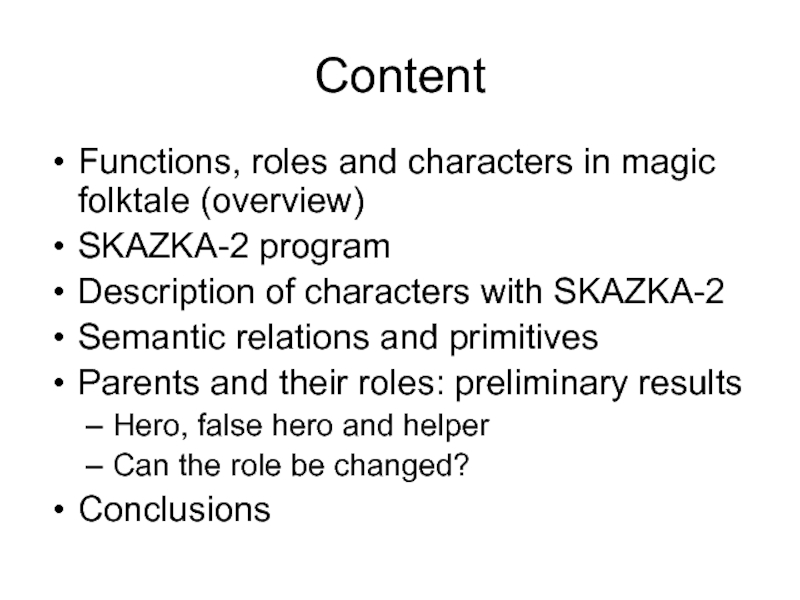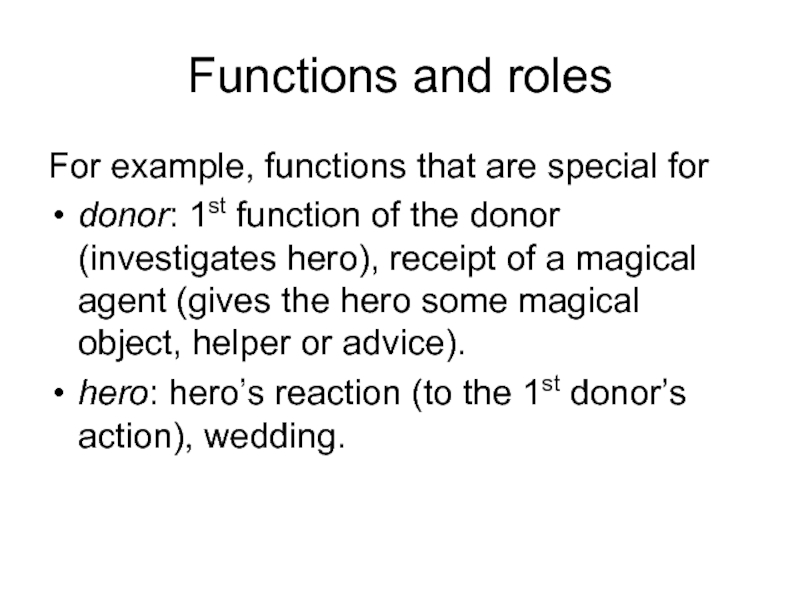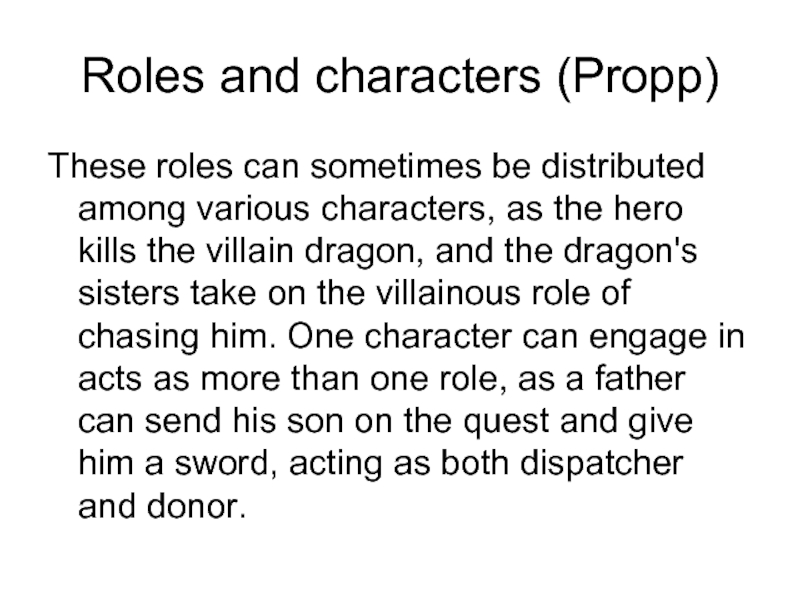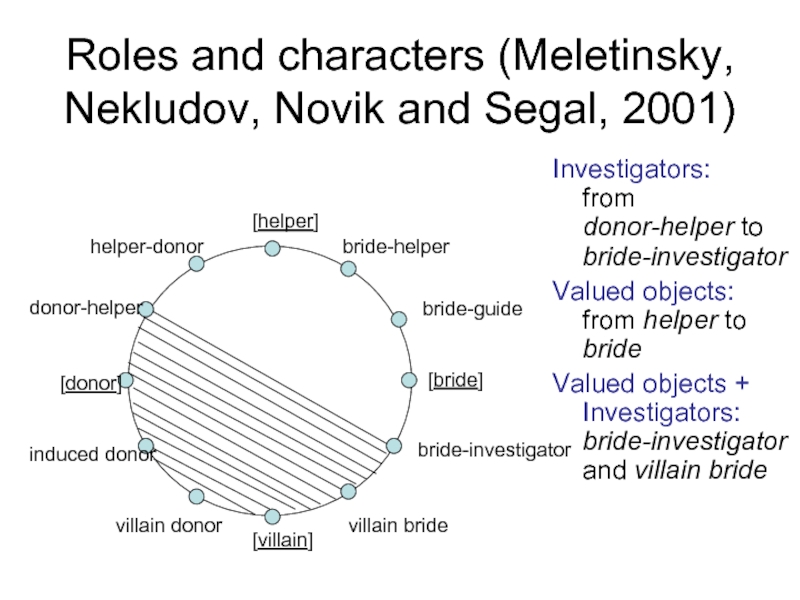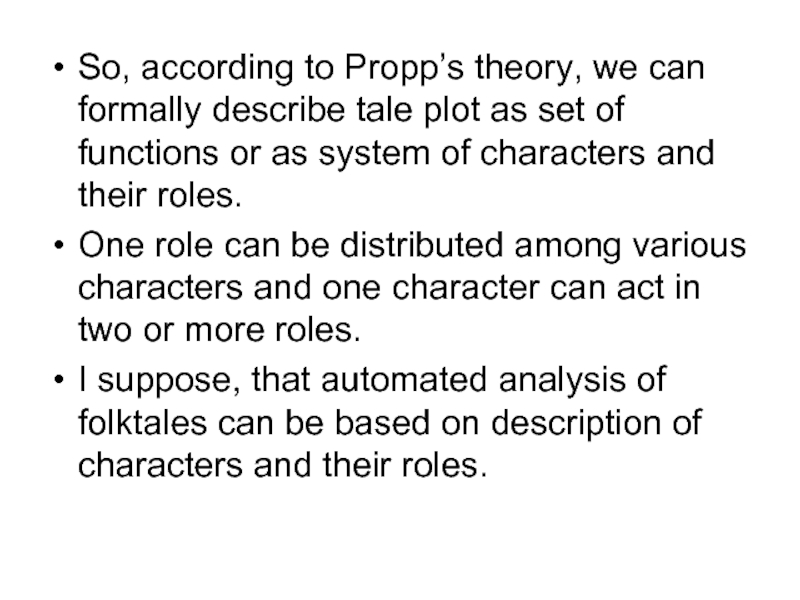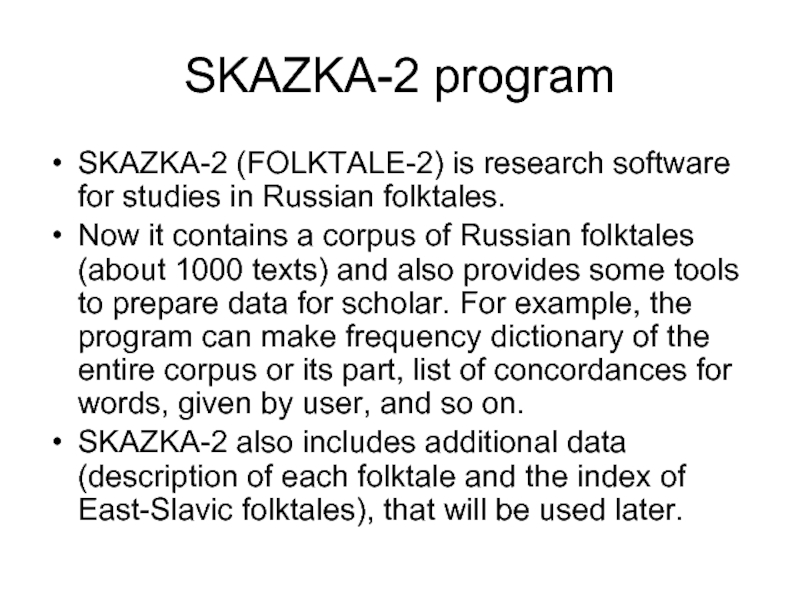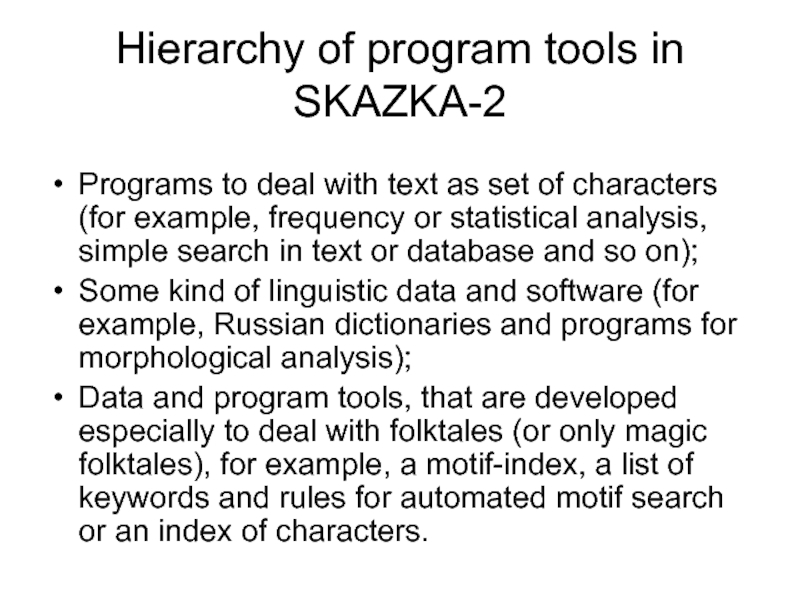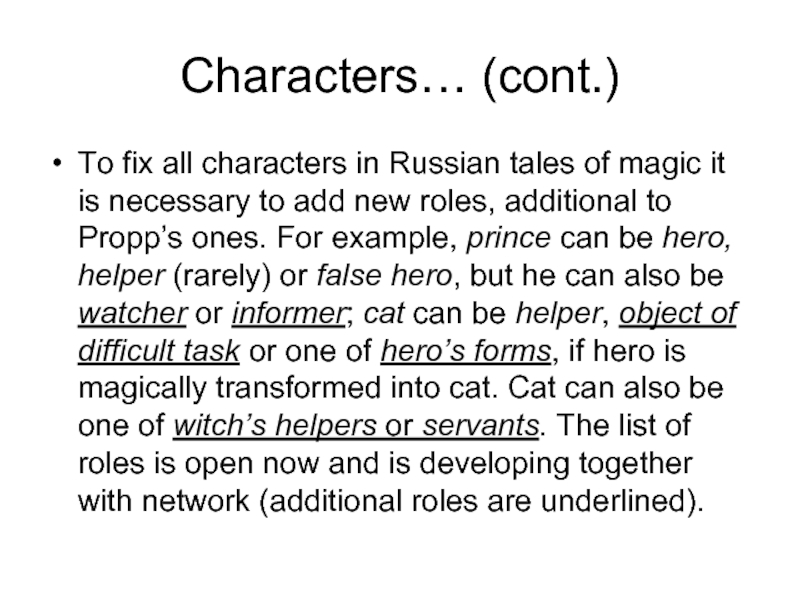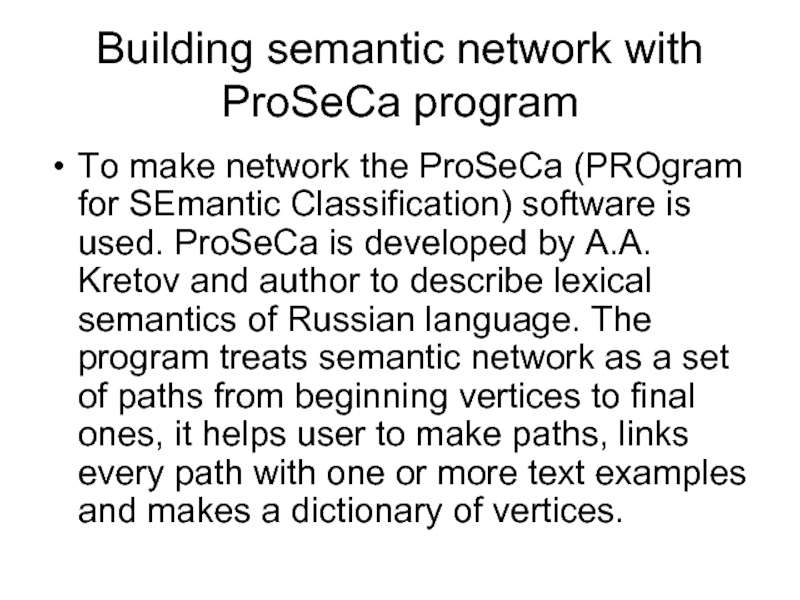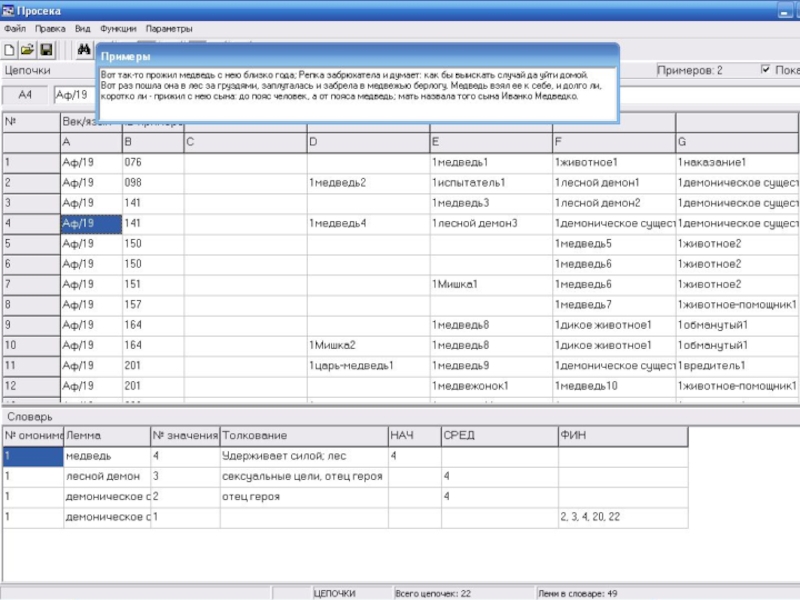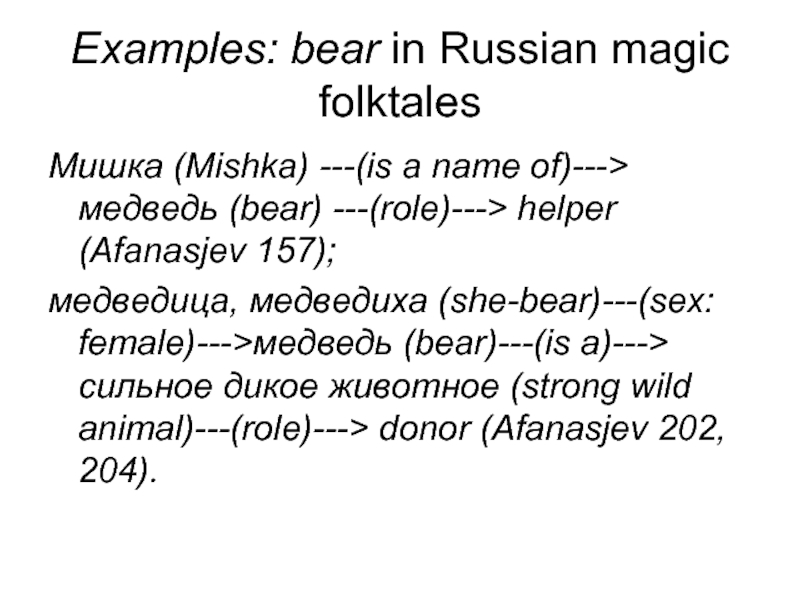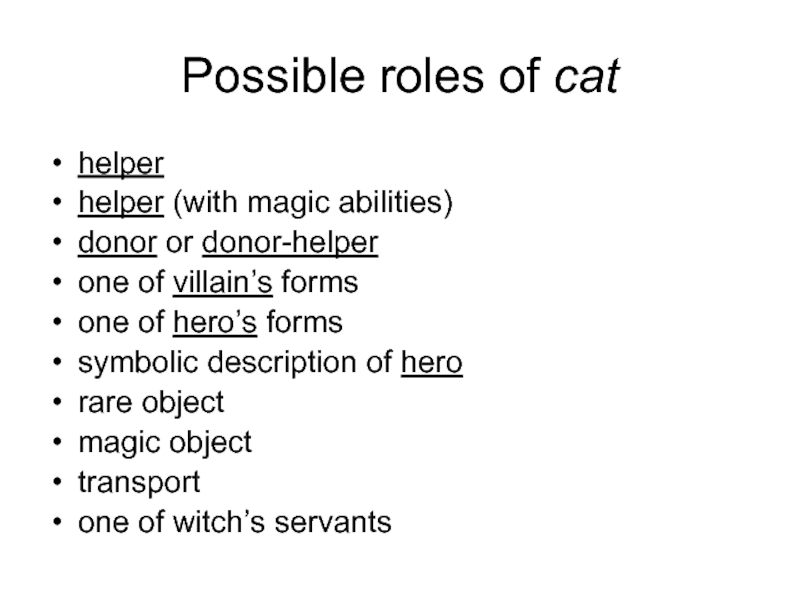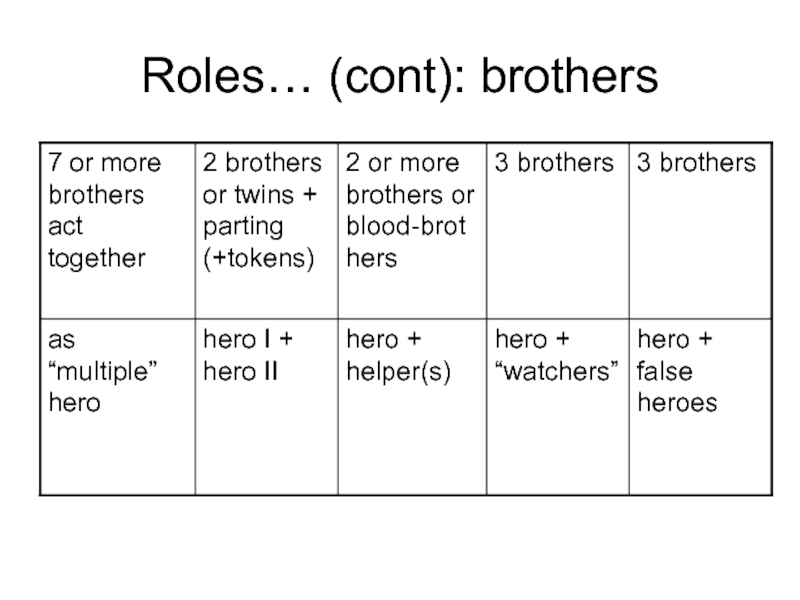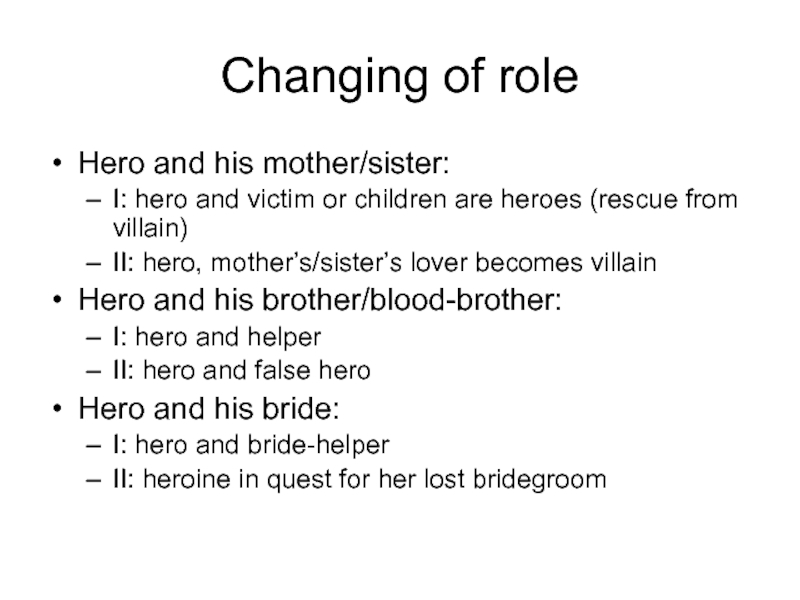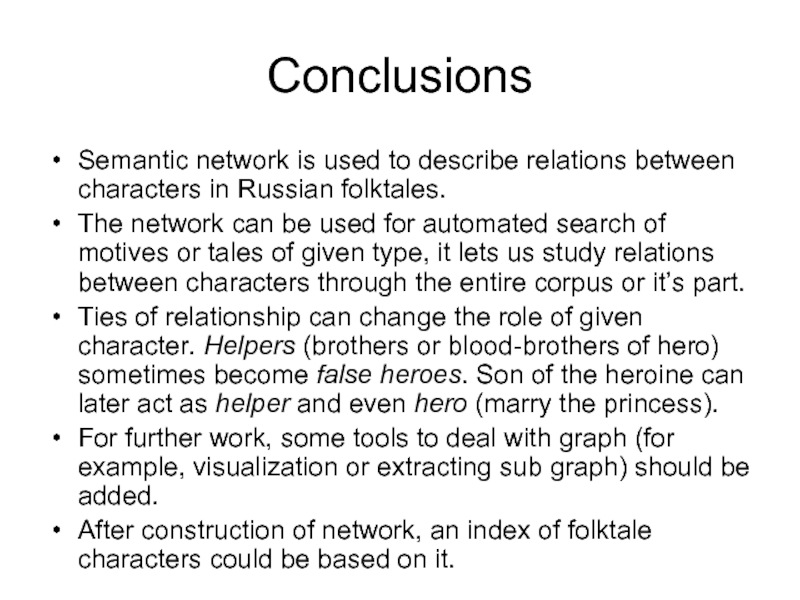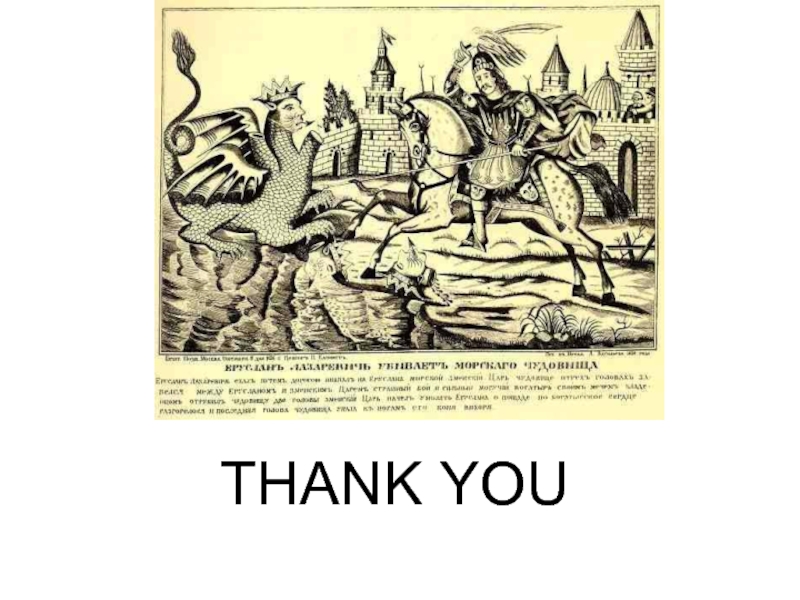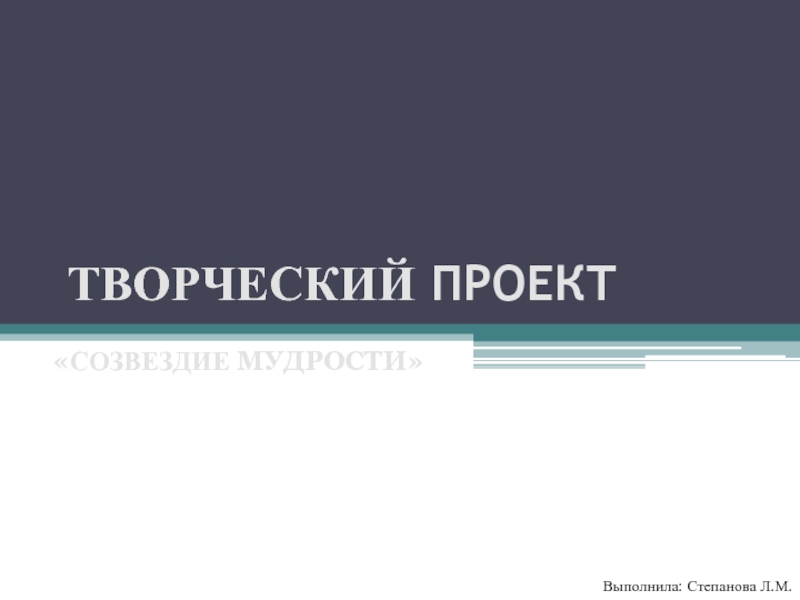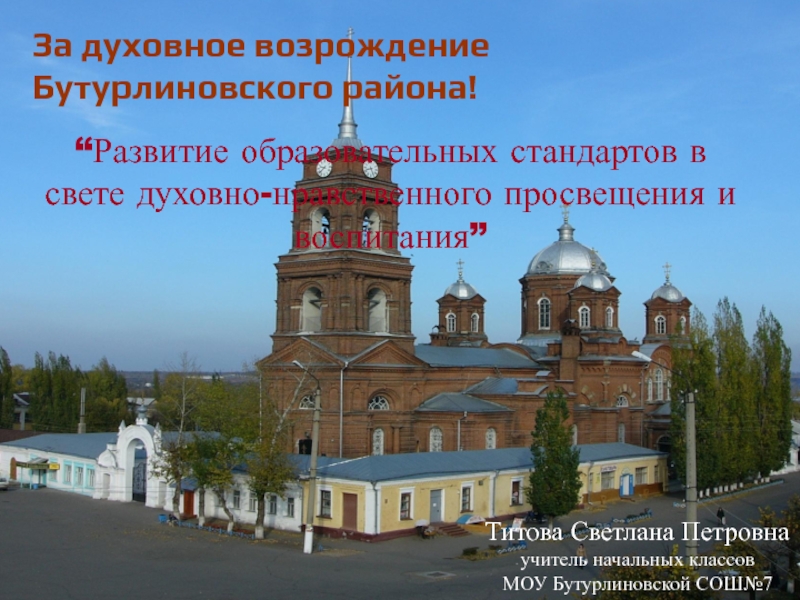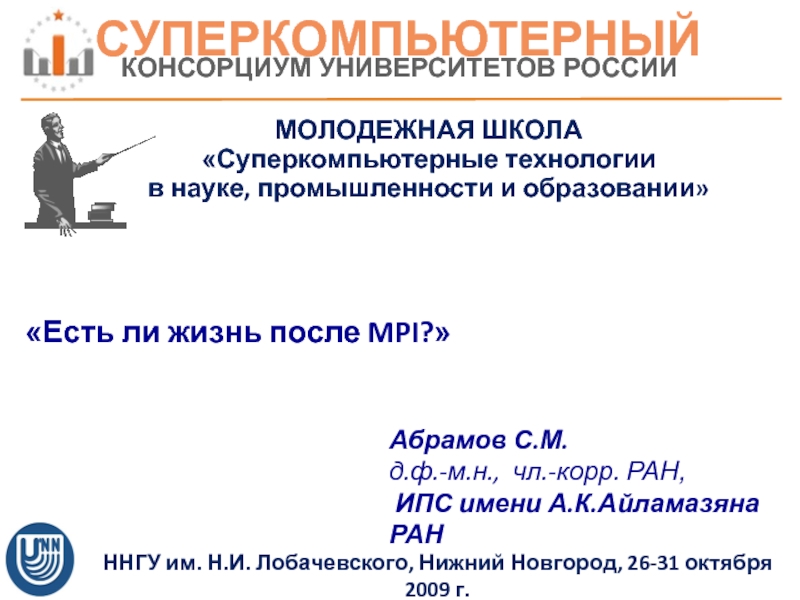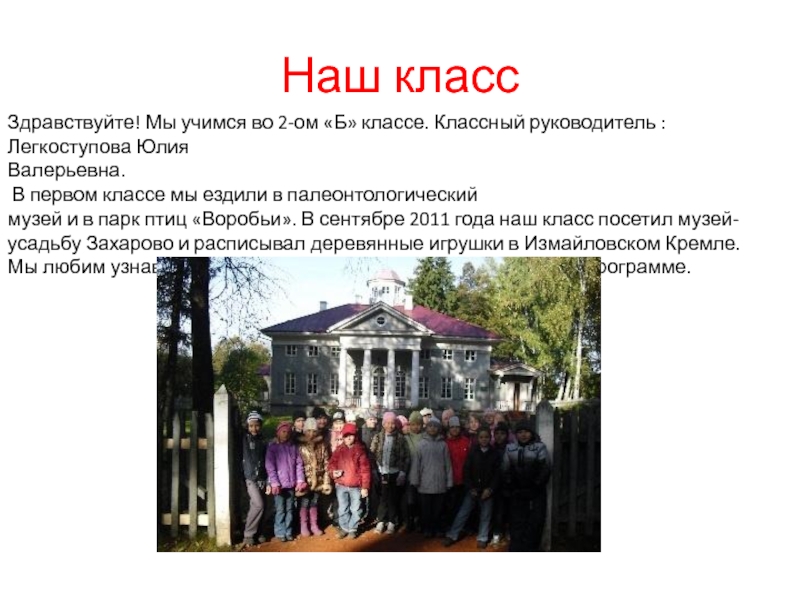University, Russia
anna_raf@rambler.ru
- Главная
- Разное
- Дизайн
- Бизнес и предпринимательство
- Аналитика
- Образование
- Развлечения
- Красота и здоровье
- Финансы
- Государство
- Путешествия
- Спорт
- Недвижимость
- Армия
- Графика
- Культурология
- Еда и кулинария
- Лингвистика
- Английский язык
- Астрономия
- Алгебра
- Биология
- География
- Детские презентации
- Информатика
- История
- Литература
- Маркетинг
- Математика
- Медицина
- Менеджмент
- Музыка
- МХК
- Немецкий язык
- ОБЖ
- Обществознание
- Окружающий мир
- Педагогика
- Русский язык
- Технология
- Физика
- Философия
- Химия
- Шаблоны, картинки для презентаций
- Экология
- Экономика
- Юриспруденция
Description of Propp’s Roles in Russian Magic Folktales презентация
Содержание
- 1. Description of Propp’s Roles in Russian Magic Folktales
- 2. Content Functions, roles and characters in magic
- 3. V. Propp defined magic folktale… with the
- 4. Functions and roles For example, functions that
- 5. Roles and characters (Propp) These roles can
- 6. Roles and characters (Meletinsky, Nekludov, Novik and
- 7. So, according to Propp’s theory, we can
- 8. SKAZKA-2 program SKAZKA-2 (FOLKTALE-2) is research software
- 9. Hierarchy of program tools in SKAZKA-2 Programs
- 10. Characters in SKAZKA-2 Study of folktale characters
- 11. Characters… (cont.) To fix all characters in
- 12. Building semantic network with ProSeCa program To
- 14. Examples: bear in Russian magic folktales Мишка
- 15. Possible roles of bear villain monster, supernatural
- 16. Possible roles of cat helper helper (with
- 17. Roles and ties of relationship: hero and his bride or heroine and her bridegroom
- 18. Roles… (cont): brothers
- 19. Roles… (cont): mother + son (AaTh 706, 707)
- 20. Changing of role Hero and his
- 21. Conclusions Semantic network is used to describe
- 22. THANK YOU
Слайд 2Content
Functions, roles and characters in magic folktale (overview)
SKAZKA-2 program
Description of
characters with SKAZKA-2
Semantic relations and primitives
Parents and their roles: preliminary results
Hero, false hero and helper
Can the role be changed?
Conclusions
Semantic relations and primitives
Parents and their roles: preliminary results
Hero, false hero and helper
Can the role be changed?
Conclusions
Слайд 3V. Propp defined magic folktale…
with the use of 31 functions:
…and as
tale with 7 roles:
Villain – Dispatcher
Donor – Hero
Helper – False hero
Princess and her father
Villain – Dispatcher
Donor – Hero
Helper – False hero
Princess and her father
Слайд 4Functions and roles
For example, functions that are special for
donor: 1st
function of the donor (investigates hero), receipt of a magical agent (gives the hero some magical object, helper or advice).
hero: hero’s reaction (to the 1st donor’s action), wedding.
hero: hero’s reaction (to the 1st donor’s action), wedding.
Слайд 5Roles and characters (Propp)
These roles can sometimes be distributed among various
characters, as the hero kills the villain dragon, and the dragon's sisters take on the villainous role of chasing him. One character can engage in acts as more than one role, as a father can send his son on the quest and give him a sword, acting as both dispatcher and donor.
Слайд 6Roles and characters (Meletinsky, Nekludov, Novik and Segal, 2001)
Investigators:
from donor-helper
to bride-investigator
Valued objects: from helper to bride
Valued objects + Investigators: bride-investigator and villain bride
Valued objects: from helper to bride
Valued objects + Investigators: bride-investigator and villain bride
Слайд 7So, according to Propp’s theory, we can formally describe tale plot
as set of functions or as system of characters and their roles.
One role can be distributed among various characters and one character can act in two or more roles.
I suppose, that automated analysis of folktales can be based on description of characters and their roles.
One role can be distributed among various characters and one character can act in two or more roles.
I suppose, that automated analysis of folktales can be based on description of characters and their roles.
Слайд 8SKAZKA-2 program
SKAZKA-2 (FOLKTALE-2) is research software for studies in Russian folktales.
Now it contains a corpus of Russian folktales (about 1000 texts) and also provides some tools to prepare data for scholar. For example, the program can make frequency dictionary of the entire corpus or its part, list of concordances for words, given by user, and so on.
SKAZKA-2 also includes additional data (description of each folktale and the index of East-Slavic folktales), that will be used later.
Слайд 9Hierarchy of program tools in SKAZKA-2
Programs to deal with text as
set of characters (for example, frequency or statistical analysis, simple search in text or database and so on);
Some kind of linguistic data and software (for example, Russian dictionaries and programs for morphological analysis);
Data and program tools, that are developed especially to deal with folktales (or only magic folktales), for example, a motif-index, a list of keywords and rules for automated motif search or an index of characters.
Some kind of linguistic data and software (for example, Russian dictionaries and programs for morphological analysis);
Data and program tools, that are developed especially to deal with folktales (or only magic folktales), for example, a motif-index, a list of keywords and rules for automated motif search or an index of characters.
Слайд 10Characters in SKAZKA-2
Study of folktale characters and their formal definition is
interesting by itself, and an index of characters can be used for a number of purposes, for example, for automated motif definition. Now an index of characters in the form of semantic network is under constructions. It connects characters, as they are given in folktale, their roles in fairy tale and other semantic relations.
Слайд 11Characters… (cont.)
To fix all characters in Russian tales of magic it
is necessary to add new roles, additional to Propp’s ones. For example, prince can be hero, helper (rarely) or false hero, but he can also be watcher or informer; cat can be helper, object of difficult task or one of hero’s forms, if hero is magically transformed into cat. Cat can also be one of witch’s helpers or servants. The list of roles is open now and is developing together with network (additional roles are underlined).
Слайд 12Building semantic network with ProSeCa program
To make network the ProSeCa (PROgram
for SEmantic Classification) software is used. ProSeCa is developed by A.A. Kretov and author to describe lexical semantics of Russian language. The program treats semantic network as a set of paths from beginning vertices to final ones, it helps user to make paths, links every path with one or more text examples and makes a dictionary of vertices.
Слайд 14Examples: bear in Russian magic folktales
Мишка (Mishka) ---(is a name of)--->
медведь (bear) ---(role)---> helper (Afanasjev 157);
медведица, медведиха (she-bear)---(sex: female)--->медведь (bear)---(is a)---> сильное дикое животное (strong wild animal)---(role)---> donor (Afanasjev 202, 204).
медведица, медведиха (she-bear)---(sex: female)--->медведь (bear)---(is a)---> сильное дикое животное (strong wild animal)---(role)---> donor (Afanasjev 202, 204).
Слайд 15Possible roles of bear
villain
monster, supernatural being (villain)
helper or donor-helper
donor (for she-bear)
hero’s
father (villain I)
one of hero’s forms (transformation into bear as hero’s ability)
one of hero’s and his wife’s forms (transformation into bear as punishment)
one of bride’s forms (as the result of enchantment)
strong and dangerous wild animal
wild animal as an object of hunt
one of hero’s forms (transformation into bear as hero’s ability)
one of hero’s and his wife’s forms (transformation into bear as punishment)
one of bride’s forms (as the result of enchantment)
strong and dangerous wild animal
wild animal as an object of hunt
Слайд 16Possible roles of cat
helper
helper (with magic abilities)
donor or donor-helper
one of villain’s
forms
one of hero’s forms
symbolic description of hero
rare object
magic object
transport
one of witch’s servants
one of hero’s forms
symbolic description of hero
rare object
magic object
transport
one of witch’s servants
Слайд 20Changing of role
Hero and his mother/sister:
I: hero and victim or
children are heroes (rescue from villain)
II: hero, mother’s/sister’s lover becomes villain
Hero and his brother/blood-brother:
I: hero and helper
II: hero and false hero
Hero and his bride:
I: hero and bride-helper
II: heroine in quest for her lost bridegroom
II: hero, mother’s/sister’s lover becomes villain
Hero and his brother/blood-brother:
I: hero and helper
II: hero and false hero
Hero and his bride:
I: hero and bride-helper
II: heroine in quest for her lost bridegroom
Слайд 21Conclusions
Semantic network is used to describe relations between characters in Russian
folktales.
The network can be used for automated search of motives or tales of given type, it lets us study relations between characters through the entire corpus or it’s part.
Ties of relationship can change the role of given character. Helpers (brothers or blood-brothers of hero) sometimes become false heroes. Son of the heroine can later act as helper and even hero (marry the princess).
For further work, some tools to deal with graph (for example, visualization or extracting sub graph) should be added.
After construction of network, an index of folktale characters could be based on it.
The network can be used for automated search of motives or tales of given type, it lets us study relations between characters through the entire corpus or it’s part.
Ties of relationship can change the role of given character. Helpers (brothers or blood-brothers of hero) sometimes become false heroes. Son of the heroine can later act as helper and even hero (marry the princess).
For further work, some tools to deal with graph (for example, visualization or extracting sub graph) should be added.
After construction of network, an index of folktale characters could be based on it.
